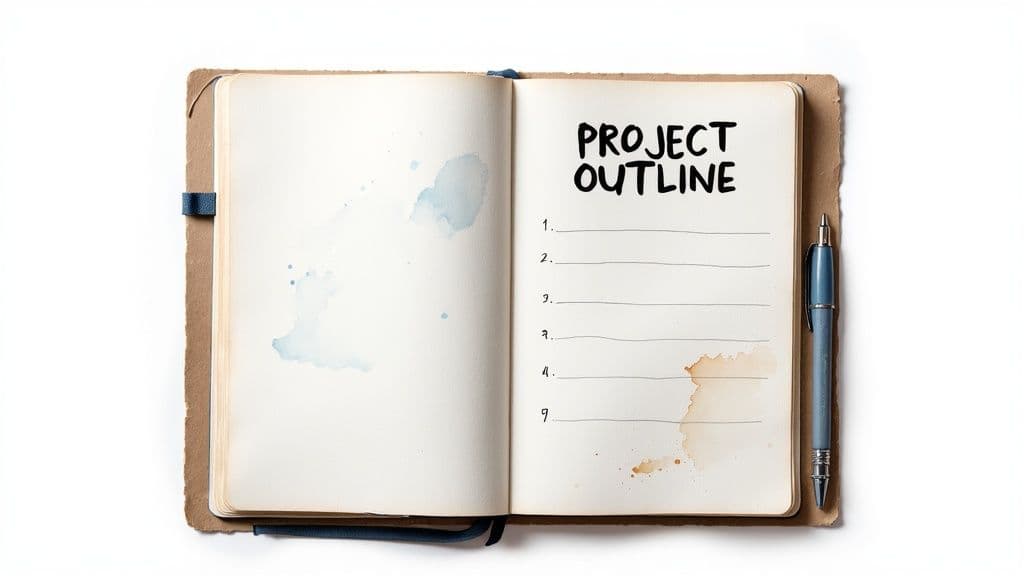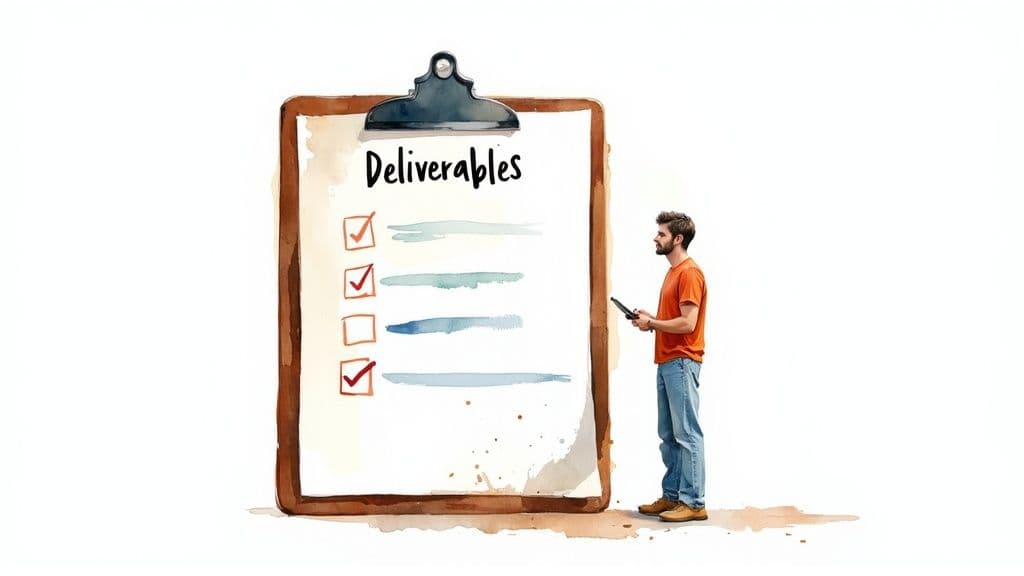A practical guide to the project outline format. Learn how to structure your plan, define scope, and align teams to deliver projects on time and budget.
August 17, 2025 (3mo ago)
Mastering the Project Outline Format for Success
A practical guide to the project outline format. Learn how to structure your plan, define scope, and align teams to deliver projects on time and budget.
← Back to blog
Think of a good project outline format** as your project's constitution. It's the foundational document that lays out the rules of engagement—defining the goals, scope, and key deliverables before anyone writes a single line of code or lays a single brick. It turns a promising idea into a concrete, actionable plan, getting everyone on the same page from the get-go.
Why a Solid Project Outline Is Non-Negotiable

Let's be real for a moment. Most projects don't fail spectacularly during the execution phase. They die a death of a thousand cuts, starting with a simple lack of clarity right at the beginning. A solid project outline format serves as that single source of truth, fighting off the scope creep and miscommunication that can poison even the most brilliant concepts.
For instance, picture launching a new marketing campaign without a proper outline. Before you know it, the budget is a mess, deadlines are flying by, and key stakeholders are all pulling in different directions. Now, imagine that same launch with a structured outline. Everyone knows the goals, the boundaries, and exactly what success looks like from day one.
The Foundation of Project Success
This document is far more than a simple to-do list; it’s a living, breathing communication tool. It forces you and your team to critically think through every essential component before a single dollar is spent or a single hour is logged. To really appreciate its importance, it helps to understand the comprehensive responsibilities of a project manager, as this outline is one of their most powerful instruments for guiding a project home.
A well-crafted outline doesn't just list tasks. It tells the story of the project—where you're going, why it matters, and how you'll navigate the journey together.
The data backs this up, time and time again. Organizations that put in the upfront work of detailed project outlining see their success rates climb. In fact, projects with a clear, structured outline manage to meet their original goals 79% of the time. Compare that to just 53% for projects that lack a formal plan. The difference is stark.
A robust outline provides:
- Clarity and Alignment: Everyone, from the intern to the CEO, is reading from the same playbook.
- Proactive Risk Management: It helps you spot potential roadblocks and plan for them before they become emergencies.
- Effective Resource Allocation: You get a clear picture of exactly what you need—people, budget, and tools.
- Clear Success Metrics: It establishes what "done" truly means before the work even begins.
Finding Your Project's North Star: Objectives and Scope
Before you ever start assigning tasks or building timelines, you have to get two things absolutely right: your project's objectives and its scope. This is the bedrock of your entire plan. Think of it as defining your project's "North Star"—that single guiding purpose that keeps everyone pulling in the same direction, even when things get complicated.
The trick is to move beyond vague, corporate-speak goals. Saying you want to "improve user engagement" is fine, but it's not a real objective. A real objective is something you can measure and act on.
For example, instead of that vague goal, a powerful objective would be: "Increase daily active users for our mobile app's new 'Community Hub' feature by 15% within three months of launch." Now that's a target. It's specific, has a deadline, and ties directly to a business outcome. Everyone on the team knows exactly what success looks like.
Drawing a Line in the Sand with Your Scope Statement
With your objectives locked in, the next step is to define the project's boundaries. This is where the scope statement comes in, and frankly, it's one of the most critical, conflict-preventing documents you'll ever create. It’s your official record of what the project will deliver and, crucially, what it will not.
Think of it like building a fence around your yard. Everything inside the fence is your team's responsibility. Anything outside is not part of this project. For that mobile app feature we mentioned, a clear scope statement would break down like this:
- In-Scope: The project covers the full design, development, and launch of the 'Community Hub.' This includes user profiles, a tool for creating posts, and a system for comments and replies.
- Out-of-Scope: This phase will not include a direct messaging function, user-created groups, or any gamification elements like badges or leaderboards. We can explore those in a future release.
If I could offer one piece of advice from years of managing projects, it's this: get your stakeholders to sign off on the scope document before any real work begins. It’s a simple step that creates solid buy-in and gives you a shared document to point back to when the inevitable "scope creep" starts knocking at the door.
Breaking Down Your Project Into Actionable Pieces
Staring at a massive project goal can feel like looking at the base of a mountain. Where do you even start? The key is to stop seeing it as one giant objective and start breaking it down into a clear, hierarchical roadmap. This simple act transforms an intimidating monolith into a series of smaller, more achievable wins for your team.
The most effective way I've found to do this is by thinking in three distinct tiers: milestones, deliverables, and tasks. Think of milestones as the major signposts on your journey—significant achievements that tell you you're making real progress. Deliverables are the tangible, concrete things you produce and hand over. Finally, tasks are the specific, day-to-day actions required to get those deliverables done.
This isn’t just a modern management fad. The core idea of deconstructing projects has been around for decades, with roots in methods like the Program Evaluation and Review Technique (PERT) from the 1950s. By the early 2000s, this structured approach became standard, with over 70% of organizations using formal project management practices that rely on these detailed breakdowns.
From Milestones to Daily Tasks
Let's make this real with an example I've seen play out dozens of times: planning a large corporate conference. A vague goal like "Host a successful conference" is a recipe for chaos. Breaking it down brings immediate clarity.
- Milestone: A major phase is complete, like "Venue & Catering Confirmed."
- Deliverable: A tangible result of that work, such as a "Signed Venue Contract."
- Task: The specific action item needed to get there, like "Research and contact five potential venues."
This flow, from the big picture down to the daily grind, is essential for building a solid project foundation.

When you define your objectives first, then list out the deliverables needed to meet them, you create a logical and defensible plan that keeps everyone aligned.
The table below shows how this breakdown works for our conference planning scenario, illustrating the path from high-level goals to concrete action items.
Project Breakdown Example: Corporate Conference Planning
| Milestone | Deliverable | Example Tasks |
|---|---|---|
| Speaker Lineup Finalized | Signed Speaker Agreements for 5 Keynotes | - Research industry experts - Send initial outreach emails - Negotiate speaker fees and terms - Draft and send contracts |
| Marketing Campaign Launched | Completed Email Marketing Sequence | - Write 5-part email series copy - Design email template - Set up automation in Mailchimp - Schedule campaign launch date |
| Sponsorship Secured | 3 Signed Sponsorship Packages | - Create sponsorship tiers & pricing - Identify and contact 20 potential sponsors - Follow up with interested leads - Finalize agreements |
As you can see, what starts as a broad milestone becomes a set of very specific, assignable tasks. For projects that are highly process-driven, like hiring, a visual workflow can be even more powerful. It’s worth learning how to build a recruiting process flowchart to map out every step clearly.
The real magic of this method is how it connects high-level strategy to the daily grind. Your team can see exactly how their individual tasks contribute directly to major project milestones, which is a massive boost for both morale and accountability.
Mapping Your Timeline and Assembling Your Team

Once your tasks are laid out, it’s time to tackle the 'when' and the 'who' of your project. This is where you bring the plan to life by building a realistic timeline and getting the right people on board.
Visual tools like Gantt charts are incredibly helpful, but the real skill is in estimating how long each task will actually take. More importantly, you have to pinpoint the dependencies—the tasks that can't start until another one is finished.
Think back to our conference planning example. You absolutely cannot book the caterer until the venue contract is signed. That’s a classic dependency. Identifying these critical links early on is what separates a smooth project from one plagued by constant bottlenecks and delays.
Assembling the Right Team
Resource planning isn't just about putting names in a spreadsheet. It’s a strategic exercise in defining clear roles and responsibilities. Who has the final say on the marketing copy? Who owns the relationship with the guest speakers? Nailing this down now prevents a world of confusion later.
Pro Tip: I always recommend building a contingency buffer of 15-20% directly into your timeline. Delays aren't a possibility; they're an inevitability. When you plan for them, a potential crisis just becomes a manageable hiccup.
This thinking extends beyond your team, too. Don't forget to account for non-human resources. Do you need specific software licenses for the design team or special equipment for the event itself? Allocate these with the same care you give to assigning people.
Finally, think about the specific skills needed at different stages of the project:
- Initial Planning: This phase calls for big-picture thinkers and master organizers.
- Execution Phase: Here, you need detail-oriented task managers and creative problem-solvers who can adapt on the fly.
- Launch/Event Day: This is all about sharp coordination and flawless communication.
Defining these needs from the start ensures you have the right talent in the right place at the right time. And if you're juggling more than one project, a rock-solid outline becomes non-negotiable. For more on that, check out our guide on how to manage multiple projects simultaneously.
Finalizing Your Plan with Budgeting and Risk Assessment

Now we get to the part where your project outline really proves its worth. This is where a simple plan becomes a robust, real-world strategy. With your tasks, resources, and timeline mapped out, it's time to put some real numbers to it and figure out the budget. A solid budget isn't just about money; it’s about earning stakeholder trust and keeping a firm grip on the project’s financial health from start to finish.
Nailing Down the Numbers
There are a couple of ways to approach this. You can start with a top-down estimate, which is great for getting initial approval. It’s a high-level figure that gives everyone a ballpark idea of the investment.
The other method, a bottom-up budget, is far more granular. You build this by pricing out every single task and resource. It’s more work upfront, but it gives you incredible control once the project is underway.
Whichever way you start, here’s a tip I’ve learned the hard way: always include a contingency fund. Things will go wrong, and unexpected costs are a given. I recommend setting aside 10-15% of the total budget for this. Trust me, it turns a potential crisis into a manageable hiccup.
Proactive Risk Management
With your budget squared away, the final piece is thinking about what could go wrong. This isn’t about being negative; it's about being prepared. Proactive risk management means spotting potential problems and having a plan in your back pocket before they can derail your progress.
Get your team together and brainstorm. What could throw a wrench in the works? A key supplier might miss a delivery, or a critical piece of software could crash right before a major milestone.
- Identify the Risk: What’s the potential problem? (e.g., Our lead developer gets sick during a critical sprint.)
- Assess the Impact: How bad would it be? (e.g., High impact, potentially delaying the launch.)
- Determine Likelihood: How likely is it to happen? (e.g., Medium likelihood during flu season.)
A solid risk assessment turns your project outline from a static document into a dynamic tool for navigating uncertainty. It prepares your team to adapt and overcome challenges, ensuring the project stays on track even when faced with the unexpected.
Once you’ve identified the risks, you can develop mitigation strategies. For the sick developer scenario, a plan might involve having another team member cross-trained on their tasks. This kind of forethought, combined with clear communication, is what makes a project resilient. For a deeper dive on keeping everyone in the loop, our guide on creating a project communications plan template is a fantastic resource.
A Practical Project Outline Template You Can Use Today
All right, let's move from theory to action. It's one thing to understand the components of a good outline, but it’s another to build one from scratch. To give you a running start, I've put together a straightforward project outline format you can copy and paste right now.
This isn’t just a blank slate with a few headings. I’ve included guiding prompts within each section to help you think through the details and articulate your project's goals with total clarity. It covers everything we've talked about, from the high-level executive summary and objectives all the way down to the nitty-gritty of your risk assessment.
Just fill in the blanks, and you'll have a professional, comprehensive document ready to share with stakeholders and guide your team.
I designed this template to get you from the "big idea" phase to a concrete plan in minutes. Think of it as the foundational blueprint for a successful project.
If you're more of a visual learner and want to see how it all comes together, check out this complete project outline example. It shows how these components look when applied to a real-world scenario. Feel free to use this structure as your go-to starting point for any new initiative.
A Few Common Questions About Project Outlines
Once you've got the basics down, some practical questions always seem to come up. Let's walk through a few of the most common ones I hear from teams trying to get their project management process dialed in.
How Detailed Should My Project Outline Be?
The honest answer? It depends entirely on the project's complexity and who needs to read it.
For a small, internal project—say, updating a section of your company website—a simple, high-level outline is usually perfect. You'd focus on the major milestones and key deliverables, keeping it clean and straightforward so the team isn't swimming in unnecessary details.
But if you're tackling a major, cross-functional initiative with outside partners and investors, you need to get granular. That means breaking down work into specific tasks, assigning owners, and including a thorough risk assessment. Everyone involved needs a deep understanding of their role and the potential roadblocks.
A good rule of thumb: your outline should give anyone who reads it a clear picture of the project's purpose, scope, and direction without you having to explain it to them over the phone.
What's the Difference Between a Project Outline and a Project Plan?
This is a classic, and it's a great question. I like to think of the project outline as the architect's blueprint. It lays out the "what" and the "why"—the core objectives, the boundaries of the scope, and the major deliverables. It's all about the strategic vision.
The project plan, on the other hand, is the detailed construction schedule built from that blueprint. It gets into the "how" and the "when," with specific task assignments, comprehensive timelines (like a Gantt chart), communication protocols, and line-by-line budget tracking.
The outline sets the vision; the plan maps out the execution.
Can I Change the Outline After the Project Starts?
Absolutely. Projects rarely go exactly as planned. The key is how you manage the changes.
Think of your outline as a baseline, not something set in stone. When a change to the scope, timeline, or budget is needed, it should go through a formal change control process. This isn't just bureaucracy; it's about protecting the project. The change needs to be proposed, reviewed for its impact on everything else, and then officially approved by the key stakeholders.
This simple process is what stands between a controlled pivot and disastrous "scope creep." It keeps everyone aligned and ensures the project stays on track, even when the track moves.
Ready to turn those scattered to-do lists into a clear, actionable plan? Fluidwave combines AI-driven task management with a network of virtual assistants to help you organize, prioritize, and delegate work without the chaos. Stop juggling and start achieving. Visit the Fluidwave website to get started for free.
Focus on What Matters.
Experience lightning-fast task management with AI-powered workflows. Our automation helps busy professionals save 4+ hours weekly.